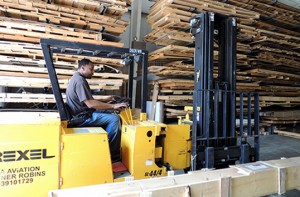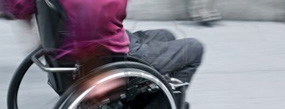In many ways, the operation of a forklift is an accident waiting to happen. Consider the conditions that most forklift operators are faced with: confined spaces, issues with driver visibility, high noise levels, other machines, people working in the area and heavy objects being moved above their heads.
The forklift itself is a heavy, densely-built machine that is usually carrying even more weight in front, moving it up and down, back and forth. It is not surprising that forklift accidents are frequent and often costly to the operator’s physical health.
According to the U.S. Occupational Safety and Health Administration (OSHA), there are nearly 35,000 serious injuries and 85 deaths each year caused by forklift accidents. About 42 percent of those are caused by the forklift tipping over and crushing the operator.
OSHA maintains that the safest place for a forklift operator is in the driver’s seat and strapped in with a seat belt. OSHA, in fact, obligates employers to make sure the seat belt rule is enforced on their property at all times.
Factors Contributing to Forklift Accidents
Even with the driver dutifully strapped in, there still are a number of factors that can contribute to a forklift accident. Many of these can be site-specific, so drivers should be shown the layout of the area and told of any work routines that might interfere with the safe operation of the vehicle.
Other safety factors include:

- Age and maintenance of the equipment
- Excessive speed
- Deadline stress
- Elevated load while driving
- Improper backing or turning
- Lack of proper accessories and tools
- Lack of proper operator training
- Improper parking
The work area itself can contribute to forklift mishaps. There can be narrow, cluttered aisles, poor lighting, busy intersections and others working in the area who could get in the way of the forklift and cause an accident. Other factors may include the load being stacked improperly or overall too heavy for the vehicle to safely carry. Additionally, the design of a forklift, where often large loads are carried in the front of the driver, could obstruct the operator’s vision where hazards go unseen and therefore become unavoidable.
Pedestrians: Do Not Enter
Pedestrians in the area of forklift operations cause their own potential for pedestrian accidents. In fact, pedestrian traffic should be separated from the vehicles by the use of walkways that are specifically designated as “no forklift zones.” When a forklift is in operation, people should be forbidden to enter the area, and all those who may need to work where a forklift may be driven should wear bright, identifiable clothing.
The design of the factory or warehouse floor can be a source of forklift hazards. Poor lighting, blind turns, intersections, noise and general congestion can all contribute to injuries involving forklift accidents. Company operating regulations should take these factors into account. For example, forklift operators should be required to sound the horn when entering an intersection and the floor should always be cleared each shift of any and all obstructions.
Forklift safety should always be the top concern in any setting. If company safety precautions are ignored, an employee who is injured as a result of a forklift accident may be entitled to workers’ compensation.





